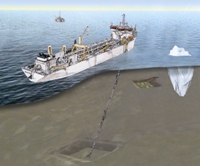Jan De Nul Books Global Offshore Contracts
 In Canada Jan De Nul‘s ‘Cristóbal Colón’, the largest THSD in the world, will excavate a Glory Hole in the Atlantic Ocean east of Newfoundland. At a water depth of 130 m, the subsea depression will protect oil installations from icebergs. The project is one of number of offshore projects that Jan De Nul added to its order book last month – totalling more than EUR 500 million.
In Canada Jan De Nul‘s ‘Cristóbal Colón’, the largest THSD in the world, will excavate a Glory Hole in the Atlantic Ocean east of Newfoundland. At a water depth of 130 m, the subsea depression will protect oil installations from icebergs. The project is one of number of offshore projects that Jan De Nul added to its order book last month – totalling more than EUR 500 million.
On the west coast of Australia, the Belgium-based marine contractor’s largest project will be for Chevron’s Wheatstone pipeline. Before installing the pipeline, trenches must be dredged in the hard seabed. In order to protect the pipeline, it must be covered with sand and rocks after installation. Furthermore, prelay rock berms have to be installed, enabling the new pipeline to cross existing pipelines.
On the east coast of the Siberian island of Sakhalin, the Fall Pipe Vessel ‘Simon Stevin’ will install umbilicals for Gazprom at 90 m water depth. These umbilicals serve to control the gas field manifolds from land. This gas field is now a priority development for Gazprom, because of an increased demand in Japan due to the shutdown of the nuclear power plants.
Further up the east coast of this island, the Cutter Suction Dredger ‘Fernão de Magelhães’ is dredging an access channel for Exxon. With this channel, barges can be brought to the shore with modules for the onshore drill site. The ‘Fernão de Magelhães’ started the works as soon as the ice had melted sufficiently – ensuring the client can make maximum use of the ice-free season.
In the Tatar Strait between Siberia and Sakhalin, Jan De Nul’s Rock Dumping Vessels ‘La Boudeuse’ and ‘Willem de Vlamingh’ are executing rock dumping works to protect a subsea pipeline from ice floes crossing the strait. The rocks are loaded in the Siberian port Sovgavan. The pipeline guarantees the connection of the gas fields east of Sakhalin with the mainland.
And finally, Jan De Nul will sail even further to the north, in the Barents Sea near Nova Zembla. The Group will execute dredging and rock dumping works to protect pipelines which are transporting gas from the Jamal Peninsula to Western Europe.
Image courtesy of Jan De Nul






